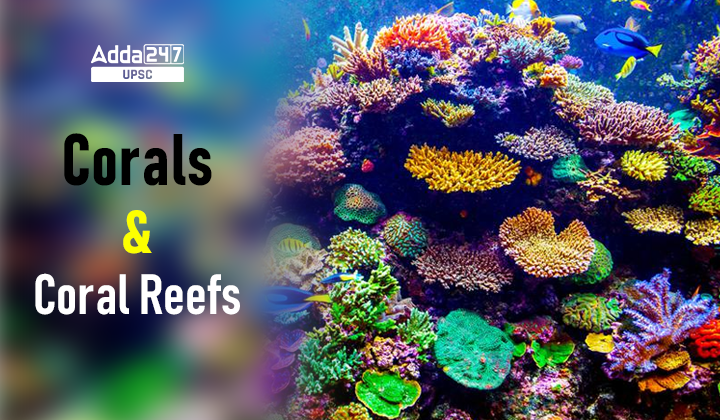Table of Contents
Relevance For UPSC
GS 3: Conservation, Environmental Pollution & Degradation
What are coral reefs?
- Corals are marine invertebrates or animals not possessing a spine.
- Each coral is called a polyp and thousands of such polyps live together to form a colony, which grows when polyps multiply to make copies of themselves.
- Corals are of two types — hard coral and soft coral. Hard corals, also called hermatypic or ‘reef building’ corals extract calcium carbonate (also found in limestone) from the seawater to build hard, white coral exoskeletons.
- Soft coral polyps, however, borrow their appearance from plants, attach themselves to such skeletons and older skeletons built by their ancestors.
- Soft corals also add their own skeletons to the hard structure over the years and these growing multiplying structures gradually form coral reefs. They are the largest living structures on the planet.
- Australia’s Great Barrier Reef is the world’s largest reef system stretching across 2,300 km. It hosts 400 different types of coral, gives shelter to 1,500 species of fish and 4,000 types of mollusc.
What are zooxanthellae?
- Corals share a symbiotic relationship with single-celled algae called zooxanthellae.
- The algae provides the coral with food and nutrients, which they make through photosynthesis, using the sun’s light. In turn, the corals give the algae a home and key nutrients.
- The zooxanthellae also give corals their bright colour.
What is coral bleaching?
- Bleaching happens when corals experience stress in their environment due to changes in temperature, pollution or high levels of ocean acidity.
- Under stressed conditions, the zooxanthellae or food-producing algae living inside coral polyps start producing reactive oxygen species, which are not beneficial to the corals.
- So, the corals expel the colour-giving zooxanthellae from their polyps, which exposes their pale white exoskeleton, giving the corals a bleached appearance.
- This also ends the symbiotic relationship that helps the corals to survive and grow.
Could Bleached Corals Survive?
- Bleached corals can survive depending on the levels of bleaching and the recovery of sea temperatures to normal levels.
- If heat-pollutions subside in time, over a few weeks, the zooxanthellae can come back to the corals and restart the partnership but severe bleaching and prolonged stress in the external environment can lead to coral death.
- Over the last couple of decades, climate change and increased global warming owing to rising carbon emissions and other greenhouse gases have made seas warmer than usual.
- Under all positive outlooks and projections in terms of cutting greenhouse gases, sea temperatures are predicted to increase by 1.5°C to 2°C by the time the century nears its end.
Mass Bleaching Events
- The first mass bleaching event had occurred in 1998 when the El Niño weather pattern caused sea surfaces in the pacific ocean to heat up; this event caused 8% of the world’s coral to die.
- The second event took place in 2002. In the past decade, however, mass bleaching occurrences have become more closely spaced in time, with the longest and most damaging bleaching event taking place from 2014 to 2017.
- This started with reefs in Guam in the Western Pacific region getting affected, to then affecting the North, South-Pacific, and the Indian Ocean.
- Global temperature in 2017, was the third-highest to ever be recorded. In the 2014-17 event, more than three times as many reefs were exposed to bleaching-level heat stress as compared to 1998.
Why do Corals matter?
- Coral reefs support over 25% of marine biodiversity, including fish, turtles and lobsters; even as they only take up 1% of the seafloor.
- The marine life supported by reefs further fuels global fishing industries. Even giant clams and whales depend on the reefs to live.
- Besides, coral reef systems generate $2.7 trillion in annual economic value through goods and service trade and tourism.
- In Australia, the Barrier Reef, in pre-COVID times, generated $4.6 billion annually through tourism and employed over 60,000 people including divers and guides.
- Aside from adding economic value and being a support system for aquatic life, coral reefs also provide protection from storm waves.
- Dead reefs can revive over time if there are enough fish species that can graze off the weeds that settle on dead corals, but it takes almost a decade for the reef to start setting up again. The reefs which were severely damaged in 1998 did recover over time.



 TSPSC Group 1 Question Paper 2024, Downl...
TSPSC Group 1 Question Paper 2024, Downl...
 TSPSC Group 1 Answer key 2024 Out, Downl...
TSPSC Group 1 Answer key 2024 Out, Downl...
 UPSC Prelims 2024 Question Paper, Downlo...
UPSC Prelims 2024 Question Paper, Downlo...





